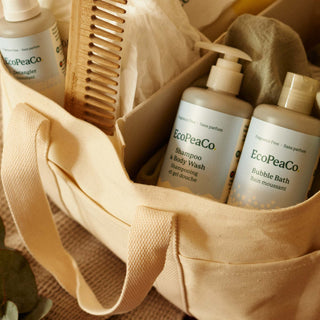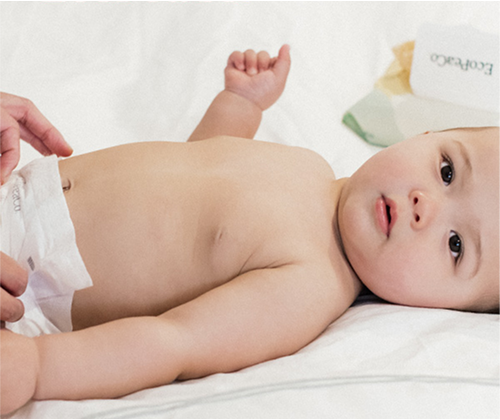Baths have become romanticized online as one of the ultimate forms of self-care. But when you have to bathe a new, fragile family member for the first time, it can be a totally different and often intimidating experience. Once you get past the fear of the unknown, bathing your baby can become a great time to bond, distraction-free with your baby. In this comprehensive guide, we’ll share all you need to know about your baby’s first bath to leave you feeling confident and ready for the experience.
When to Give Baby Their First Bath
The most common question new parents have about the first bath is “When should I give my baby their first bath?” The timing of the experience often varies depending on whether it takes place at the hospital or home. Experts have published studies on when to give your newborn their first bath, but just like most things with your baby, it often comes down to their individual needs and your healthcare provider's instructions.
In the hospital
After your baby is born, it’s standard practice for healthcare professionals to delay their first bath for at least 6 to 24 hours after birth. This is because a newborn’s skin is covered in vernix, a white, waxy substance that serves as a protective barrier. Vernix helps keep your baby’s delicate skin moisturized and provides natural immunity against infections. Delaying the bath time can help the vernix be absorbed, providing moisture and protective benefits.
However, if your baby is born prematurely or has specific medical concerns, your health care team may advise you to give a sponge bath earlier. Always follow the guidance of healthcare providers in such cases.

At home
Once you’re home with your newborn, you’ll likely continue to delay the first full bath for a few weeks. Some parents prefer to wait until the baby’s umbilical cord stump falls off, which usually happens within the first two weeks after birth.
During this time, you can start with sponge baths to keep them clean without removing the protective vernix layer prematurely. When performing a sponge bath, be sure to have the following on hand: a soft washcloth, mild, fragrance-free baby soap, warm water, a soft towel, and a comfortable, warm room. Once you have all of your supplies prepared, here is how to give a sponge bath with a gentle approach to ensure your baby’s skin stays moisturized and healthy:
- Undress your baby: Gently remove your baby’s clothes, keeping them covered with a towel or blanket to prevent them from getting cold.
- Wash their face first: Dip the washcloth in warm water and wring it out. Gently wipe your baby’s face from the inside out, using a different corner of the cloth for each eye to prevent cross-contamination.
- Clean their neck, arms, and hands: Continue to use the washcloth to clean the rest of your baby’s body.
- Clean their chest and belly: Move on to their chest and belly, taking care to clean the folds of their skin.
- Clean their legs and feet: Finally, wash your baby’s legs and feet. Be sure to clean between their tiny toes.
- Dry and dress your baby: Pat your baby dry with a soft towel and then dress them in clean, dry clothes.
After the umbilical cord stump has healed and fallen off, you can begin giving your baby regular baths, usually two to three times a week. As your baby gets older and becomes more active, you can gradually increase the frequency of baths, up to three to four times per week. However, always prioritize gentle and mild products to avoid skin irritation. Every baby is different – some may enjoy bath time and benefit from more frequent baths, while others may have sensitive skin that requires less frequent washing. Pay attention to your baby’s cues and adjust your bathing routine accordingly.

Tips for Baby’s First Bath
When the time is right and you’re ready to give your baby their first official bath, here are the best tips to keep in mind to have a successful experience:
- Choose the right time: Pick a time when you and your baby are both calm and relaxed. Avoid immediately after feeding or when your baby is overly tired.
- Maintain the right temperature: Make sure the room where you are bathing your baby is comfortably warm, around 75°F (24°C). Test the water temperature with your wrist or elbow to ensure it’s lukewarm, around 100°F (37°C). Use a reliable baby thermometer to be certain.
- Use gentle, fragrance-free products: Opt for mild, hypoallergenic baby soap and shampoo. Avoid products with strong fragrances or harsh chemicals that can irritate your baby’s sensitive skin. This goes for diapers too as chlorine can be present which is why we offer TCF diapers.
- Support your baby’s head: Always support your baby’s head and neck during the bath to prevent any accidental slips or injuries.
- Be gentle and calm: Handle your baby gently and talk to them soothingly throughout the bath. This helps create a positive and comforting experience.
- Stay organized: Have all your bath supplies within arm’s reach, so you don’t have to leave your baby unattended even for a moment.
- Practice patience: If your baby is fussy during the bath, don’t rush. Take your time and if needed, pause and comfort them before continuing.
- Dry thoroughly: After the bath, ensure you pat your baby dry gently, paying extra attention to the folds of their skin. This helps prevent newborn diaper rash. This is also a good time to ensure your baby does not have any signs of diaper allergies.
Bathing Steps:
Similar to your sponge bath technique, focusing on the order in which you bathe your baby can keep the experience running smoothly and avoid any contamination. Here are seven simple steps to bathe your baby after you’ve prepared your water.
- Undress your baby: Gently undress your baby, keeping them wrapped in a towel to maintain warmth.
- Begin with the face: Use a damp, soft washcloth to wash your baby’s face, starting from the eyes and moving outward. Use a different corner of the cloth for each eye.
- Hair and scalp: Wet your baby’s hair with a damp washcloth. Apply a small amount of baby shampoo and gently massage the scalp. Rinse with a clean, damp washcloth.
- Body wash: Apply a small amount of mild baby soap to a washcloth. Gently wash your baby’s body, starting with the neck and working your way down. Be thorough but gentle, paying attention to creases.
- Genital area: Use a mild soap or simply water to clean the genital area. For baby girls, always wipe from front to back to prevent infection.
- Rinse and dry: Rinse your baby with clean water or a damp washcloth, ensuring no soap residue remains. Lift your baby out of the water, supporting their head and neck, and wrap them in a dry towel. Make sure to properly dry your baby's ears to reduce the chance of dealing with at home ear infection remedies.
- Moisturize and dress: Apply a gentle baby lotion if needed, especially if your baby has dry skin. Be sure to connect with a healthcare provider if you have questions about when you can use lotion on a newborn. Dress your baby in clean, dry clothes and a diaper.
Post-Bath Care
Caring for your baby after their bath is just as important as the bath itself. It can save your baby from infections and develop your bond with the baby at the same time. Use these tips to care for your baby’s precious body and enjoy the post-bath relaxation together.
Cord Care (if applicable): If you’re bathing your baby when they still have their umbilical cord stump, proper care is necessary to ensure it heals correctly. Learn how to handle the sensitive area with care and follow any specific instructions from your healthcare provider.
Cuddle and bond: Skin-to-skin time with your baby after the bath provides an opportunity for bonding and comfort. These precious moments strengthen your emotional connection and create a sense of security for your baby.
Key Insights
As a new parent, your journey is filled with exciting milestones, including the first bath. By understanding when and how to give your baby their first bath, along with tips for maintaining the right temperature and using gentle, hypoallergenic products, you can ensure a safe and enjoyable experience. Hopefully you have not used all of your Eco Pea Co diapers you received at your diaper raffle. Cherish these moments of bonding and care as you embark on your parenthood journey, and remember that every baby is unique, so adapt your routine to suit your baby’s individual needs.


